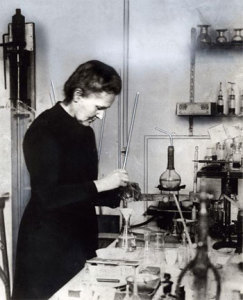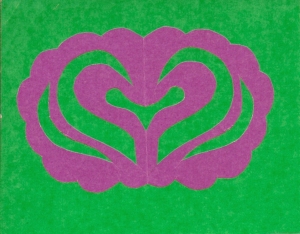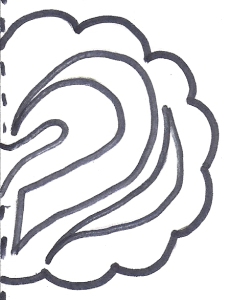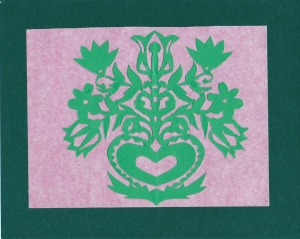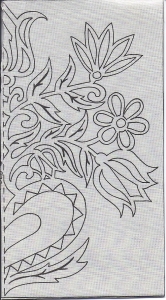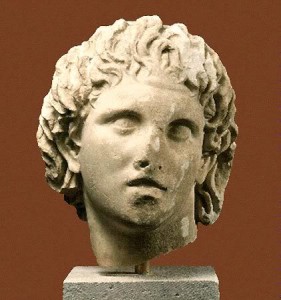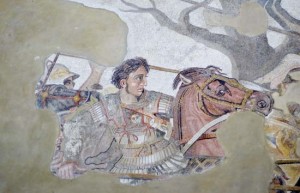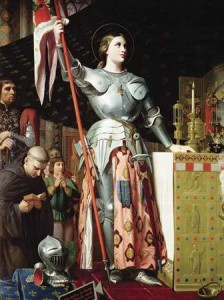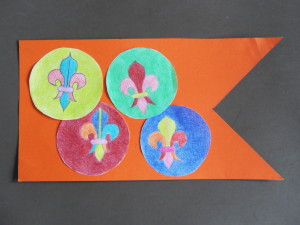When the World’s Fair opened in 1899, the Eiffel Tower stood at its entrance announcing peace and prosperity for France. This was the Belle Époque Era when the visual arts, music, theatre, dance, literature, and filmmaking prospered.
Marya Sklodowska arrived from Poland during this period of creativity and scientific and technological innovation.
She was born in Warsaw in 1867 during the Russian occupation of Poland. She was the youngest in a family that included four sisters and one brother. Her parents were Polish patriots and teachers who encouraged their children’s academic studies. When Marya was 11, her oldest sister of died of typhus and a shortly after, her mother died of tuberculosis.
Marya became depressed after her mother’s death but managed to attend the Floating University, a secret school unknown to the Russian government. The Floating University allowed women to study unlike many European universities like Warsaw University. When she was 17, Marya left home to work as a governess, supporting her sister financially through medical school. But after a failed romance with the oldest son of the household, she left Poland for Paris.
Marya was one of 23 female students in a student body of 1800 studying at the Faculty of Sciences at the Sorbonne. She lived during a time in history when few women attended high school let alone college. Marya lived in a garret that was very cold in the winter and studied so hard that she sometimes fainted because she forgot or couldn’t afford to eat.
In spite of the fact that she was poor, she grew to love Paris and all it had to offer. She changed her name to Marie.
She met Pierre Curie when she asked for space in his laboratory so she could study the magnetic properties of steel. They fell in love and married, forming a scientific partnership.
Marie continued her research influenced by Henri Becquerel who developed the x-ray and Wilhelm Roentgen who discovered that the x-ray could travel through the human body and be used to take pictures of human bones. Marie used their ideas as the basis of her doctorate.
Marie Curie achieved many “firsts” in fields dominated by men. For starters, she became the first woman in France to earn a doctorate. (Later, she became the first woman whose daughter also became a Nobel Prize recipient.)
France became her adopted country but many Frenchmen disliked foreigners and Marie Curie was often the object of their hatred. Many fellow scientists resented the fact that Marie was a prominent scientist and she often had to defend herself against their attacks. Hers was like the life of the modern woman we know today yet Marie Curie didn’t see herself as a role model for other women. She was not a suffragette or a pioneer for women’s rights although she once signed a petition protesting the arrest of certain leaders of the movement.
Perhaps she was not consciously a feminist but much of what she accomplished indicated otherwise. She never sought to “succeed in a male-dominated arena” according to her granddaughter. Rather “she simply loved science above everything else.” (Emling, pp. xi, Marie Curie and Her Daughters)
Although her research consumed her time and despite poor health, Marie gave birth to two daughters, Eve and Irene. She juggled motherhood and her career. “I have been frequently questioned especially by women, how I could reconcile family life with a scientific career. Well, it has not been easy,” she once said. (Redneiss, pp. 76, Radioactive)
In 1903, she was the first woman awarded the Nobel Prize for Physics which she shared with Pierre Curie and Henri Becquerel. She was not invited to speak at the acceptance ceremony because she was a woman.
Science was her passion. Marie discovered that radiation came from the interior of an atom. She called her discovery radioactivity. Radioactivity occurs when some types of matter give off rays of energy. She also discovered two new elements, polonium (named after the country of her birth) and radium.
One Thursday in 1906, Pierre Curie, limping in pain, was hit by a carriage while crossing the Pont Neuf and died. Years later, there was speculation that the limp was result of exposure to radiation.
After his death, the Sorbonne asked Marie to assume Pierre’s place as professor. She became the first woman to teach there, a position she accepted because she needed a paycheck to raise her daughters. Marie continued Pierre’s research on radiation and gravity and radiation’s effects on various substances. She also established a lab in honor of Pierre’s memory at the university.
Four years after Pierre’s death, she began an affair with Paul Langevin, a family friend and former student of Pierre’s. Unhappily married, Langevin’s wife made the affair public on Nov.4, 1910, while Marie and Langevin attended the International Solway Conference in Belgium. Three days after the conference, the Nobel committee announced that she won the Nobel Prize for Chemistry for discovering new elements and separating a sample of radium. She was the first woman to win a second Nobel Prize in a second field.
The press in France scorned and criticized Marie once the affair with Langevin became public knowledge. They more interested in her private life than in her accomplishments. The French were not alone in their hostility. Before the acceptance ceremony, several Nobel committee members asked Marie to avoid attending the ceremony and embarrassing the Royal family of Sweden and the Nobel Committee.
On Dec. 5th, Marie wrote to the Nobel committee: “The steps that you advise seem to me a grave error…There is no connection between my scientific work and the facts of a private life.” (Pp.134. Redniss) Marie accepted in person anyway. The affair with Langevin was over by then.
Many believed that the press and others criticized Marie because she was a woman. Her friend Marguerite Borel noted that “none of this would have happened if Marie were a man.” (Pp.9 Emiling, Marie Curie and her Daughters.)
When Marie returned to Paris from Sweden, she entered the Family of Saint Marie convent where doctors operated to remove lesions from her kidneys. She lost weight and wrote her will. Lingering rumors and the need to recuperate, compelled her to leave Paris for the countryside and later, the south of England.
World War I broke out in 1914. She returned to France and established military field radiological (x-ray) centers for wounded French soldiers. She converted her savings into war bonds and managed to take her radium supply to Bordeaux where the French government had established itself in exile.
After the war, she worked for the Radium Institute studying the uses of radioactivity in medicine. Pierre Curie had guessed that radium could be used to treat cancer but after his death, scientists found out that too much radioactivity could cause cancer, too.
On a visit to America, the reluctant feminist became aware of her influence when she met young women who aspired to study math and science. She also achieved her goal for coming to the United States: she was given a gram of radium bought by donations from Americans from all walks of life. She also raised funds to set up research and treatment centers at the Radium Institutes of Paris and Warsaw. In 1922, she was the first woman elected to the Academy of Medicine.
For most of her life, her love of science made her oblivious to the effects of radiation on her health. Doctors and others began to realize that radiation could do bad as well as good to the human body but Marie Curie refused to accept the facts. She never stopped working until the end when she felt so ill that she finally agreed to enter a clinic.
Marie Curie died there on July 4, 1934 of “aplastic pernicious anemia.”
ADDITIONAL FACTS: Pierre and Marie Curie were laid in the Pantheon in Paris. The Pantheon is a mausoleum which also houses the remains of Voltaire, Zola, Rousseau, Hugo and Langevin. Marie is the only woman interred in the Pantheon based on her own merits. The Bibliotheque Nationale continues to store the Curie’s laboratory notebooks where they are still radioactive 100 years later. Stamps and coins the world over feature their profiles and countless schools, streets, subway stops and even holidays bear the Curie name. There is even a Marie Curie crater on Mars and the Asteroid 7000 Curie orbits inside the asteroid belt between Mars and Jupiter.
TO LEARN MORE ABOUT MARIE CURIE: Emiling, Shelley. Marie Curie and Her Daughters. NY: Palgrave Macmillan, 2012. Lin, Yoming S. The Curies and Radioactivity. NY: PowerKids Press, 2012 Meltzer, Brad. Heroes for My Daughter. NY: Forty-Four Steps, 2012 Redniss, Lauren. Radioactive. NY: It Books, 2012 ART PROJECT:
WYCINANKI: POLISH CUT-OUTS
Wycinanki is a craft popular in Poland. The complex designs, cut out of thin paper, included plants, animals and people. When completed, the cut-outs looked like delicate lace. Traditionally, women and children made the paper cut-outs in the spring when the walls of homes were freshly white-washed. They would then glue the wycinanki high on the wall where it met the ceiling.
Wycinanki are still popular today and made for the tourist trade and collectors.
Materials: Pattern for the heart cut-out
Colored paper – light-weight is best
Soft pencil like a No. 2 or an HB pencil
Paper clips
Embroidery scissors
Masking tape
Tracing paper
Spray adhesive or glue stick
- Anchor the pattern on a flat surface with masking tape.
- Place tracing paper over the pattern; tape the corners of the paper down and trace the design carefully.
- Measure the design. Double the size. Measure and cut the colored paper to that size and fold the paper in half.
- Flip the tracing paper and blacken the back of it with the pencil. Wash your hands of pencil smears.
- Flip the tracing paper again so that the original tracing is on top. Place it on the colored paper. Align the fold of the colored paper and the left side of the design. (See diagram above.) Tape all four sides of the tracing and colored paper on the board. Or clip everything together with paper clips. Maintain margins of about ½” on the other three sides.
- Trace again and press hard so that the lines of the design show on the colored paper.
- Remove tracing paper. Clip or tape the sides of the folded paper and cut. Look at the design carefully when cutting.
- Carefully unfold the wycinanki and press it as flat as possible. Using spray adhesive or glue sticks, mount the cut out on a piece of contrasting colored paper. Frame it and hang it in your room.
Below is a Wycinanki for advanced cut-out artists with pattern:

